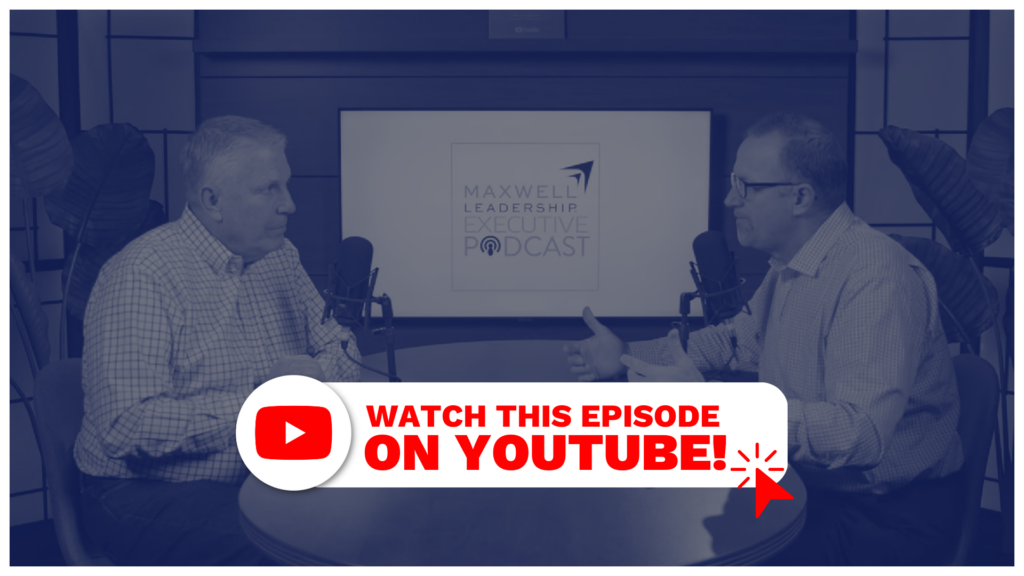Executive Podcast #261: Leveraging Diversity – Dealing with Differences

Seeing different perspectives is often one of the first steps toward solving complex cultural problems that impact multiple parts of a business or team.
When a leader does not recognize and work well with differences, they will risk people on the team deciding it is just safer to be like the leader. This leader loses all the advantages of having a diverse team.
Download our Learning Guide for this podcast!
Perry Holley:
Welcome to the Maxwell Leadership Executive Podcast, where our goal is to help you increase your reputation as a leader, increase your ability to influence others, and increase your ability to fully engage your team to deliver remarkable results. Hi, I’m Perry Holly, a Maxwell leadership, facilitator and coach.
Chris Goede:
And I’m Chris Goede, executive vice president with Maxwell Leadership. Welcome and thank you for joining. As we get started today, I want to encourage you to visit Maxwellleadership.com/podcast. If you’ll click on this episode, there’s a form at the bottom there and we’d love to hear from you if you want to download the Learner’s Guide. If you want to learn more about a new training course that we have out called Leading Multi Generational Teams, which Perry took some of Tim Elmore’s content, developed it into a corporate training course for us. And so if you’re interested in that for your team, I’d encourage you to fill out that form and let us know. Well, today’s topic is titled leveraging Diversity dealing with Differences. And I think it was an episode or two, we were talking a little bit about the content you created around Inclusive Leadership and was just delivering it the other day for a client of ours.
And we talk about the importance of having a diverse team, but also that a leader must learn to accept and work with the differences that present themselves in the diverse workforce that we all work in. And so talk to us a little bit about this topic, this title, what drove this for our listeners today?
Perry Holley:
Yeah, so a lot of talk about De and I diversity, Equity, inclusion going on. We do talk a lot about the eye in that inclusiveness and Leveraging. I think when you’re an inclusive leader, you really take advantage of the full diversity of the team. But I was given a keynote recently on a topic of leading the multigenerational teams and I really had just shown the welcome slide and guy in the front row has a sorry, I’m giggling.
Chris Goede:
Because I was there for and he.
Perry Holley:
Just says rather loudly, might I say he says, I don’t know why these young people just can’t assimilate and pay their dues just like the rest of us had to do. And I glanced at him and the room was dark, but he was close enough to the front. I could see he was probably my age and baby boomer, and that he was not dealing well with the differences. And while I did not appreciate the uproar it caused in the room with the other 150 people in there, I did appreciate the opportunity to be able to address that fundamental issue that many of us have, is that we like things like us, we have a like me bias. We appreciate people like us and personalities like us and styles like us and ages like us. But that’s not what diversity is about. And if there’s a bunch of me running around on the team. It’s just not that going to be a winning strategy.
So I need diverse backgrounds. Probably say diversity often is taught as gender and race and generation and ethnicities and things like that, which it definitely is. But it’s also diversity of thought, diversity of experiences, diversity of backgrounds, those types of things. So I love this is if you’re not going to really take advantage of the diversity on the team by being an inclusive leader, then you’re going to struggle with getting the full advantage of a diverse team. So I say you got to really deal with differences.
Chris Goede:
What I didn’t tell you is halfway through that question that you received in that room, I ran out the back door. Mary’s got this one.
Perry Holley:
I noticed when I looked up for some help.
Chris Goede:
And you talk about this word diverse, what we’re really talking about is meaning people that are different from the leader, different from you. To your point. I like the comment that you said about we have a like me bias. By the way, the last time I checked, the DNA that’s inside me is not in anybody else around the world, including you and other team members. Right. And we’re thankful for it.
Perry Holley:
We’re thankful for that.
Chris Goede:
Yeah, that was payback for me running out of the room when Perry had to deal with that speaking engagement. But we do need to understand that we all have differences. There’s basically us. And then we need to understand there’s everyone else in the world, and that is part of our team. And we need to understand, how do we lead effectively, how do we leverage the diversity of the team? Not leverage it for you as a leader, but leverage it for the team’s sake and then make sure that we can all deal with the differences.
Perry Holley:
Well, the idea that if you do hire well and you intentionally hire a diverse set of backgrounds and people that have they think differently, they see things differently, they’ve got different experiences, that’s really a beautiful thing because it allows you to learn things and see things that you would not normally see. And if you don’t appreciate this and leverage this difference, what happens is you hear the term psychologically safe is that people determine quite quickly, is it psychologically safe to be myself here? And if not, I’ll just salute and stay mute and let you. And now you hear this term assimilate, and they assimilate to be like you. And now you’ve lost all the value of the diverse team. And I’ll just be honest, I’ve been guilty of this. And I think a lot of us, like me, not intentionally doing something, it’s just so much easier to do things my way. And the way I see things goes.
Chris Goede:
Back to the bias. Right. It just naturally gravitates very much towards our own bias.
Perry Holley:
Very much so. And I don’t know, the older I’ve gotten, so now. There’s all these generations that are under me now, and in this they’re bringing so much of a different point of view. It’s so easy, just like that guy, to say, why can’t you just get with the program? No, I don’t want you to get with the program. I want you to help me see a new program, perhaps. And it takes a little bit of a secure leader, but also someone that’s a little knowledgeable in the cultural differences that are happening, not only generationally, but gender wise and ethnically. And there’s so many differences that can add value, but we miss it if we don’t.
Chris Goede:
I think that I want to camp out for just a minute on this bias comment about being able to deal with differences. I think as we are younger in our career or our leadership or influence, I feel like we develop some behaviors, not everybody, but where you begin to deal with those differences. I think it was interesting you talked about that individual in that comment. I think the older we get, the more complacent we get in not growing ourselves. We have a hard time dealing with the differences. And this is maybe not completely relevant, but it made me think about my dad, who is getting a little bit older in age. And when he was younger, man, we would have people over at the house and people be using this and taking that and coming back, and he was just like, man, that’s what you need. And now the older he gets, I see him sitting on the back porch barking at people that are in his yard.
Right. Because I think that it’s becoming much more different for him now. And I think it’s just relative for us to think about that as leaders. I’m not going to say that that guy stood up and started barking at you in the audience, but it may have been that, but he kind of did, and I ran out the door. But we do have these bias, and I think as younger, the younger we are, we tend to learn and deal with them. But I think we get more complacent the older we get, which is wrong. We should become more because of the things we could learn from the differences that are on our team.
Perry Holley:
I saw this comedian through this thing in your 20s. Somebody said, hey, we’re heading off to go do something. He goes, I’m in. I didn’t even tell you what? I don’t care. I’m in. Let’s go. And your 30s, you say, Where are you going? What time are you going to be home? How long are you going to be gone in your 40s? I’m not going.
Chris Goede:
That’s exactly right. It’s almost how I feel about sporting events. I’m like, I’m not going. I’ll sit at home. Let’s get back on topic because I completely told you I had a thought. I’m taking down a rabbit trail, but there’s a difference between someone feeling that they belong and then feeling that they need to fit in, and we don’t want them to have that feeling of where they feel like they need to try to fit in to the team. We want them to feel like they belong. And when people feel a sense of belonging, not only you as their leader, but the team as a whole in the organization will reap benefits from their differences, from their uniqueness.
And, oh, by the way, teams are going to benefit from your differences and your uniqueness as well. And so it’s contagious that if you lead by allowing this to happen and leveraging the diversity, it’s going to come the other way as well. And when people feel that they must try to fit in, man, you’re going to lose the benefits of that. I know that there are times I’ve been on teams where I have to like, okay, how do I fit in? And they’re going to lose the genius of how my DNA was created or whoever that might be that’s having those feelings.
Perry Holley:
It’s not safe to be myself. So I’ll just fit in and be what you want me to be. Just lost all the diversity that we had, the value, all the diversity.
Maxwell Leadership Growth Plan Ad:
Leaders, you know better than anyone that growth is essential if you want to make tomorrow better than today. But fitting growth into your calendar takes intentionality and self discipline. So let Maxwell Leadership help make your growth achievable. You’re invited to join thousands of worldwide leaders in using the Maxwell Leadership Growth Plan. The Maxwell Leadership Growth Plan provides you with convenient and easy to implement leadership resources, including video lessons from John Maxwell, all at your fingertips. Available in our Maxwell Leadership app or online, you’ll be coached by many well known leadership experts that will help you achieve your growth goals. You can even listen to this podcast right there in the app. Check it out for free today at Growth.MaxwellLeadership.com. That’s Growth.MaxwellLeadership.com.
Perry Holley:
I’ll give just a few tips on how we can leverage this differences that are on our team. And we can go quick on this first one because I know we talked about it a few weeks ago and we’ve got a course on this, and I just mentioned it a minute ago that if you are it’s called de I diversity, equity, and inclusion. If you want the value of this diversity, diversity is a requirement, I believe, but inclusion is a choice, and you as a leader have to make a choice that I’m going to exercise inclusive behaviors. And so I think you need to decide I’m going to be a more inclusive leader. And as you said, I think a couple of weeks ago now, but you said that you never saw a leader that purposely wanted to exclude anybody, right? I don’t do it on purpose. You would never say, I’m going to exclude my team, but we do through our behavior. So I think that when you decide I’m going to become inclusive. You do.
And I’ll just remind the statement that I use is that you make people feel that they belong. The word you were just using, that they are welcome here, that it is safe, psychologically safe to be here, and that I value you. And so when people feel that, that they feel like they can bring their full, diverse set of beliefs and backgrounds and experiences to you, you’re now leveraging differences.
Chris Goede:
That’s great. Well, this leads us to tip number two. Increase your awareness of strengths and weaknesses of every person on the team. We as leaders, get in a hurry, we get busy and we tend to just see everyone the same. They’re not the same, right? Perry and I are not the same as myself and my son are not the same. Myself and Jake are not the same. Our producer. We’re not the same.
And so we all have unique strengths and gifts that can contribute in different ways to work with the team and trying to accomplish what we’re doing. I often think here when we talk about this is that we hire people to our team because we love the strengths that we see. That may be a gap in our team that we don’t have. And then we get them into the system, we get them onto the team and we go, hey, don’t do that. Hey, don’t like or you don’t ask the questions or you don’t tap into that, man, think about the genius that you saw during that, why you hired that individual in them most often. That is their strengths. Now you’re going to become aware of some of their weaknesses over time. You can help coach and coach them through that and develop that, but man, don’t stifle that and really kind of become aware and leverage their strengths.
Perry Holley:
I heard author and researcher Liz Wiseman in her book Multipliers, so she used a term that kind of captured my attention. She asked, do you know the unique intelligence was her term the unique intelligence of every person on your team? I would urge you to make a little spreadsheet there and put the name and say, what is the unique intelligence of each individual? How well do you know their strengths and weaknesses that are on there? And it really is an exercise to determine how do you see people? Do you see people for the unique value that they bring to the team and are you aware of that or do you just see them as cogs in the wheel of getting the job done? And I think there’s a lot of value in leveraging differences if you recognize the uniqueness that everybody has on that. Tip number three would be increase the quality of your communication to the team. I’ve heard John say that people can tell by how you communicate whether you’re trying to motivate me or manipulate me. How do you see communication is key in almost everything?
Chris Goede:
Well, no doubt about it, people are watching you all the time and specifically how you communicate with them. Not only how, but how often you are communicating with them. And that says a lot about how you see them. I think about this and sometimes we get busy in an office and when individuals that maybe I report to or have reported to in the past, where they just walk by a couple of times and don’t even communicate or acknowledge, I’m like, what do I need to do now to fit in? Do I really belong into this kind of cycle? And so here are some communication tips for you as you think about this so that you can again leverage this diversity. Number one, seek their input by asking great questions. Number two, seek their point of view before sharing your point of view. I love you always say this. I love it.
I have a point of view, but I want to hear yours first.
Perry Holley:
Their stuff that sound a lot like mine, right?
Chris Goede:
That’s exactly right. Number three, listen when they speak. What listen to when they speak. And then finally, as we think about this from a communication, be curious about their perspectives.
Perry Holley:
I love that. Our friend Tim Elmore, when he’s talking about the new kind of diversity in his book, but we had him on the podcast here and we asked him as he’s talking about these communicating to different generations. I said as a baby boomer myself, talking to these Gen Z or maybe a Gen Y millennial, it can seem so different. There is a lot of differences there. Tim, how do you talk to, how do you communicate with this younger generation? And he had the most profound thing. I hope our listeners will write this down because I think about it all the time, is that I talk like I’m right, but I listen like I’m wrong. So I can talk boldly, I can say bold things. I have a point of view.
It’s part of my confidence as a leader. But I listen like I’m wrong. That introduces humility into the mix. And I just love that to say, I definitely have a point of view, but I want to hear your point of view. And by the way, I’m going to be listening as if my point of view might be wrong. And that just invites this diverse group of people you have to belong not to fit in, that you value me for what I bring.
Chris Goede:
Yeah, I think the frequency of communication has a lot to do with people feeling that they belong. Kind of the illustration I just used a minute ago. And when you only communicate issues that the team’s dealing with or assignments or it’s just work related, people are going to go back to the word you used a little while ago about they’re going to feel manipulated, and that’s not what we want them to feel. So I would encourage you, especially with your direct reports, when you’re having your regular one on one or your team meetings or informal conversations, you increase the belonging feeling. And that psychological safety that Perry has talked about before. And so you develop that relationship that communicates care and respect. And the note I wrote down here was just, man, that is the foundation of leadership at level two and the five levels of leadership where they’re going to give you permission if you do that properly.
Perry Holley:
I agree. Well, this final thought I had was that and I put this into the inclusive leader course. And I cringe when I did it because it can be quite technical, but I remove all the technical. But there was a sociologist named Milton Bennett who did a lot of research, built a model that shows a lot of this. But his scale, what I love about it, and to keep it simple, take the complexity out of it, was the scale went from how do you see difference? And it was from the low ends of I deny it. I deny differences all the way to integration integrated into everything I do. And I found that when I was in this kind of work, before Joni Maxwell leadership was most people give themselves a lot more credit. There’s a scale in there about I accept it.
And most of us say that’s where we are, but we’re not. We’re in some sort of denial or we’re in some sort of defense about differences or where I find a lot of people, we minimize it said, Well, I don’t see difference. I don’t see color. I don’t see no. When you start to do that, you diminish that person. You diminish that uniqueness that they bring. And so I bring this up only to say is that you probably think you’re better at this than you are. And I know I thought I was better at this than I was.
And I had to kind of wake up to the fact that I tend to minimize things. I tend to not kind of defensiveness about differences. I want to leverage differences. And there’s so much that we’ve done, made a lot of progress in diversity, got a ways to go, but I think we’re making a lot of progress. But we’re going to kill it all if we’re not being inclusive and making people feel welcome and that they belong on these teams so that I can leverage the differences.
Chris Goede:
Well, as I wrap up, I got two things for you. We’ve shared a lot about the inclusive leadership that we just have a passion for, right? John believes in believing in and adding value to it unconditionally loving all those that we come in in contact with. And so, as you could tell, Perry’s so well versed in this and delivering it to a corporate audience. Just the other day. I want to encourage you to go to our website, and if you’re interested, there’s more information about it there. We would love to come and serve you and your team for that. But what I would like for you to do right away is I’d like for you to share this episode. A lot of our leaders, I know a lot of people that you coach and others that our coaches coach, they take our little 20 minutes lessons here, and then they have their team listen to them, and then they discuss it at the next time that they’re together.
I want to encourage you to do that with this one, if you’re willing, if you’re bold enough to say, hey, I want to do a better job of leveraging diversity on our team, and I want us all to deal with differences. I want you to send this to them, have them listen to this podcast, and then you guys debrief it in your next team meeting.
Perry Holley:
Terrific. Well, as Chris mentioned, if you’d like to go to Maxwellleadership.com/podcast, you can get a learner guide for this episode. You can also leave us a question or a comment or learn about our other offerings or see perhaps the other parts of our podcast family of offerings that are there. We love hearing from you, and we’d love that you would be a part of this today with us. That’s all today from the Maxwell Leadership executive podcast.
To be a Successful Leader, You Need Feedback on Your Leadership.
We’re excited to announce our new and improved Organizational Effectiveness Survey (OES). The OES gathers feedback from employees to give leaders and management the knowledge and action plans needed to develop a more effective and productive work environment. Our new version measures 4 areas of your business: Leadership, People, Strategy, and Performance.













Be the first to comment on "Executive Podcast #261: Leveraging Diversity – Dealing with Differences"